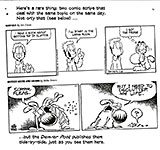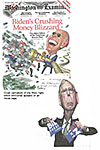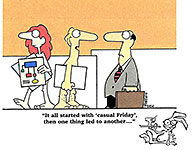 |
|||||||||||||
Opus 426 (February 25, 2022): This posting of Rancid Raves is devoted almost entirely to discussing editorial cartoons—because last posting we reviewed almost no editorial cartoons: the last posting was so dang bulky that we stopped before doing any editoon discussion because we were pretty sure we’d trespassed on readers’ attention long enough. We postponed editoonery until this opus. Now here it is. But there are a few other amusements: a long piece on editoonist Pat Oliphant in retirement, some history of Cahoots (my rabbit signature), Valentine’s Day in the funnies, J.Lo’s dress, and a generous sprinkling of gag cartoons throughout the Editoonery department. With that as introduction, let’s plunge right in—the water’s fine—:
NOUS R US
WAY OUT THERE in the far reaches of the Internet, Jim Engel paused in the rush of daily drudgery to remember that Johnny Hart’s B.C. strip started on February 17, 1958. And we do the same here with the accompanying illustration.If you want to know more about Hart and B.C., visit Opus 204, which is devoted almost entirely to both—and to Brant Parker, who, with Hart, did The Wizard of Id strip.
IT’S ABOUT TIME If you can’t
make the cover of Time magazine, the next best spot is at the other end,
the last page where the weekly interview is conducted. And that’s where we find Art Spiegelman in the issue for February 28/March 7. We’ve posted the
entire page nearby because you don’t want to miss a single syllable. Art is
both witty and informed, bitting and brilliant, serious and satiric. Take a
look. To read it, print it out. The interview is prompted by the “banning” of his celebrated graphic novel, Maus, in the eighth grade of the McMinn County, Tennessee public schools; we reported this and related matters last time at great length in Opus 425. One of Art’s bon mots struck me particularly. Those who seek to muzzle what school children read or experience are more interested in “protecting” children than in “educating” them. But what are schools for? Babysitting only? Bravo, Art. Spiegelman is a cartoonist and authority on cartooning. He is also very careful of his reputation and his image. The photograph that accompanies Time’s questionnaire is a perfect example of the latter of his preoccupations. The vest he’s been wearing for some time; ditto the chin stubble. The hat is a new addition to his image. So is vaping. Hat on his head and an e-cigarette in his hand. Today’s image.
DIRTY DOINGS AT THE PLAYBOY MANSION Just as we began working up a report on the history of Playboy magazine and its founder Hugh Hefner (which we hope to post in Harv’s Hindsights next month, or so), A&E launched a docuseries on the same subjects, “Playboy’s Secrets,” in which former bunnies and Playmates testified to the nastiness of life at the Playboy Mansion, Hef’s den of sexual depravity and drug addictions. I’ve
thought for some years that Playboy was a manifest of Hef’s adolescent
sexual yearnings. He imagined a luxurious life full of sexual and other
satisfactions of the flesh, and then, with the millions the magazine earned, he
was able to bring his imagination into reality, first building a mansion where
such things are possible and then playing the role he had invented for himself
as the ultimate playboy. He seduced young women into the mansion and then into roles as his sexual playmates by convincing them that sexual licentiousness was the ultimate FREEDOM—akin to the freedom to which the founding fathers dedicated the U.S. Constitution and related writings. This freedom, he doubtless explained, was denied to all of us by the restraints imposed upon American life by its puritanical first residents. Yes, his targets would agree—we are restrained by our puritanical history. And by the same reasoning, we can achieve true freedom by indulging our sexual aspirations. And so the fantasy life at the mansion was formulated and practiced. Ironically, the portrait of Hefner in the first few years of publishing Playboy was startlingly different. He worked all the time. Every hour, day and night, he devoted to editing the magazine. And articles written about him stressed the ironic aspect of his life as editor/founder. Yes, he had a big round bed. And yes, he lived in a mansion in downtown Chicago and Playmates and wannabees lived there, too. But the time he spent in their embrace was mere seconds taken furtively away from his 24-hour preoccupation with the magazine. Work, work, work was the byline, not play, play, play, the magazine’s impulses notwithstanding. “Playboy’s Secrets” divulges none of this. It focuses on his abuse of women (they were all “sex objects,” “disposable,” “sexual playthings,” “the women were always there to be handled,” and the like). The abuse, while personal—conducted initially and mostly for Hef’s sexual gratification—had national, even international, ramifications. Playboy—and therefore Hef—did indeed change the world. And sometimes, not for the better. Hef’s licentiousness did loosen up the traditional moral restraints in puritan America; but the Playboy Mansion and lifestyle was still the exception, not the rule, in American life. The testifying witnesses to all of this abuse are persuasive. But there are only a half-dozen of them. Where are the multitudes? If what the few testify to is true, there should be dozens more witnesses to the abuses. I haven’t quite either discounted the stories as exceptions rather than the rule or bought in whole-heartedly to their truth. I’m still making up my mind. If you are also viewing “Playboy’s Secrets,” you might enjoy the article we produced here in Harv’s Hindsight for September 2008 and in Opus 349, which examines (and decries) the magazine’s giving up publishing photos of barenekkidwimmin. In Hindsight, attend particularly to the editorial Hef wrote for Shaft, the campus humor magazine at the University of Illinois, where he attended in the late 1940s.
FURTHER ADO As yet, no law has created the equality enshrined in the nation’s founding documents. Indeed, the challenging lesson from our nation’s history is that a deep well of strength and resilience is required for the long struggle to make equity and equality under the law a reality in the United States.—Anthony Siracusa, University of Colorado Boulder
PAT OLIPHANT IN RETIREMENT Oliphant, arguably the most revered (and feared) editoonist of the last half century, retired several years ago, leaving all of us fans grieving deeply. I never knew why he retired, but in the article that follows, we find out—failing eyesight. We’re posting the entire article by Andy Stiny of the Albuquerque Journal because he tells us what we all want to know: what’s Oliphant up to these days? He uses a cane and moves slowly but the mordant wit guiding the pen that launched thousands of political cartoons skewering the powerful and despotic is still evident. He’s taken on Putin, Nixon, the Clintons, Kim Jong-un and countless other politicians and dictators. The unique character of his cartoons, that at one time were syndicated in an estimated 500 newspapers worldwide, is unmistakable. Pat Oliphant, 86, sips coffee in his Santa Fe home studio as he tells a reporter he has not drawn for several years after his eyesight deteriorated. Dressed
casually in a blue shirt and cardigan sweater with a shock of white hair, he
relates a career that started in his native Australia as he playfully banters
with his wife of over 30 years, Susan Conway Oliphant. “The thing he liked was studying the features and what part of a politician was telling and what he stood for,” said Conway Oliphant. “Did I say that, I must say that in the future,” Oliphant responds. “I don’t know how I survived in here, it’s bloody cold,” he said, as he sat in the studio filled with small notebooks in which he first sketched cartoons. A mutual friend introduced the couple in Washington, D.C., where Conway Oliphant owned an art gallery after becoming an art conservator and studying in France. They bought their home here in 1996 but Oliphant has been coming to Santa Fe since his days at the Denver Post in the 1960s and ’70s. “It’s been a long association,” he said. He went on to work at the Washington Star during Watergate and then his work was syndicated and also appeared for several years in the [Wall Street] Journal. In those days, he read two newspapers and watched a morning news show to start his day and then hit the drawing board where for some 60 years a cartoon was finished by noon to be transmitted to newspapers worldwide. “It all comes together at one time after you make up your mind what you want to say,” said Oliphant. “That’s when the fun starts, otherwise you scrap the whole thing and start again.” “That doesn’t happen very often,” said Conway Oliphant. The studio, infused with natural light, displays numerous sculptures that Oliphant created simultaneously with his cartoons as well as wood carvings he tinkered with. He shows visitors a caricature figure of Richard Nixon bent over with his hands covering his private parts. That’s titled “Nixon Holding His Own,” said Conway Oliphant. “She always blushes when she has to say that,” Oliphant teases her. He started as a copy boy at his hometown paper, the Adelaide News. It’s one of Rupert Murdoch’s early papers, and Oliphant gives the media mogul no quarter. “There is nothing great about Murdoch, he should have been euthanized early,” said Oliphant. His parents nurtured his drawing talents and he became a political cartoonist at 20. He immigrated to the U.S. in 1964 to become the cartoonist for the Denver Post [which had been without an editoonist since Paul Conrad left for California]. Political columnist Fred Brown worked with Oliphant at the Post. “What a magnificent character!” Brown said in a phone interview. Oliphant had a penchant for cartoons that would never make it into a family paper— such as LBJ naked, said Brown. “Oh yeah, I did a lot of those,” Oliphant said, when told of the anecdote. He
lamented the changing media environment, which he thinks has weakened the
political cartoon trade. “They’re not but they could be (still powerful),” he said. “Something happened with the Internet, I don’t know what it was that really killed off (cartoons) … in some strange way it terminated the use of good cartoons. The practitioners are no longer treating it as an art, which it is.” Oliphant’s cartoons are populated with villains, which he needs for inspiration. “I should say Trump,” he answers when asked what villains would get him mad today. But he was “not to my satisfaction,” able to capture the ex-president. “I did him several times, but getting that self-satisfaction in his face, it’s almost impossible to voice really my disgust for that guy,” he said. Oliphant frequently depicted Russian President Vladimir Putin, sometimes as an oversized figure looming over dissidents or as the shirtless “Superslav” racing on horseback. He often includes Punk, the little penguin he invented in Australia, at the bottom of cartoons, who in this cartoon opines, “That Putin is a riot.” A lifetime of reading has underscored his sense of justice. “I like to take the side of the guy that I think is worthwhile … There’s an attitude of being for the little guy, the oppressed, being on the side of the guy who needs a little lift.” In the early days, Oliphant would give drawings away to admirers, but now his wife is learning about and compiling a database for posterity and for scholars to research. “We are keeping the whole body of work because it’s too important as a history of the second half of the last century,” she said. About 10,000 have been catalogued but Oliphant may have done as many as 15,000 or 20,000, said Conway Oliphant. About 7,000 originals have been gifted to the University of Virginia in Charlottesville, and the Library of Congress has several thousand. Yale University has some. Conway Oliphant is still in awe of her husband’s body of work. “I think he’s a miracle,” she said. “To get up in the morning and think about what you are going to do that day … and how he’s going to say what he thinks and get it out by noon … and to do it every day for 60 years.” If not for the cartoon decline and his eyes, Oliphant might still be skewering his next target. “We have seen the demise of a perfectly good mode of expression, it’s awful and I don’t know how it will ever be resuscitated,” he said. “I miss it every day of my life because it was something I enjoyed, really enjoyed.”
RCH: Nearby, a
photo of Oliphant and me at the time I met him at the annual convention of the
Association of American Editorial Cartoonists in 2013 at Salt Lake City. Alas,
the person taking this historic picture didn’t wait for my camera to focus Although
my invention of Cahoots in 1955 preceded his 1964 arrival at the Denver Post,
I was reasonably sure that people would think I was imitating Oliphant with my
rabbit signature. (As best I can recall, I was actually inspired by another
editorial cartoonist, Fred O. Seibel, who, at the Richmond
Times-Dispatch, signed his cartoons with a crow, which, at first, he called
Jim Crow, but in recent years with the emergence of a fresh sensibility, he
changed the name to Moses.) So for many years, I retired Cahoots. (That’s what I call him, but that’s not his name. His name, of course, is Harvey.)
A couple years before our “formal meeting” at the AAEC, I attended a talk given by Oliphant, and afterwards, I went up to him with my sketchbook and, introducing myself as a former resident of Denver—where he had also lived when working on the Post— I prevailed upon him to draw his Punk next to my Cahoots. He added the speech balloon, which you can see hereabouts.
QUOTES & MOTS There is a word for what the Trumpet and his Trumpists did when they stormed the Capitol. That word is treason.
TRUMPERIES The Antics and Idiocies of Our Former Bloviating Buffoon in Chief YOU’D THINK THAT THE TRUMPET, after being rejected in the last election, would be filling out his days quietly seeking obscurity. Oh, no. Not the Trumpet. He’s still holding those monster rallies during which he insists that the election he lost was rigged for the other candidate to win. It had to be rigged because, as everyone knows, the Trumpet isn’t a loser. Can’t be. Fortunately for us, the news media isn’t covering Trump’s every syllable these days. They evidently learned that it was their coverage of his idiocies before and during the 2016 Election that, in effect, created the Trumpet. Without their excessive coverage, he would not have existed let alone won the election. But the Trumpet is expert at making a sensation or an oddity of himself, so extreme that the media cannot always ignore him. So he is in the news occasionally. And editoonists, with so delicious a target, hovering always in the political background, can’t help themselves: they are, after all, cartoonists, and when a cartoon walks right up and kicks them in the shins, the draw a picture of it. Our
first visual aid is kicked off by Ruben Bolling’s Tom the Dancing Bug,
a full page comic strip in which the Trumpet appears as a small boy named
Donald. In this episode, Donald is whining about losing the election, but
before long, he finds a way to rejuvenate his self-image—just as his Trumpet
namesake has done. I’ve included John Darkow’s picture of the Trumpet with his hands in the cookie jars because it is such a great picture and so perfectly captures the essential infantile Trumpet even though it was created to comment on Trump’s Ukrainian adventure long ago. Then Steve Sack shows the Trumpet preparing for the next election with his playbook already in operation—“Start the Steal” indeed. Dave
Whamond starts the next Trumpet display with a comment on recent
developments. It turns out that the former Prez was breaking the law by
destroying Presidential Papers, and Whamond’s image captures all of the methods
Trump used—burn bags, shredder, and, laughably enough, the toilet down which he
reportedly flushed torn-up fragments of official documents that he no longer
had a use for. His use of the toilet for that purpose explains a complaint he
registered early in his administration about how many times one must flush a
toilet to get the desired results. And, of course, the Grandstanding Obstructionist Pachyderm won’t let us forget Hillary’s e-mails. Next, Kevin “Kal” Kalaugher has produced a comic strip that shows an examiner questioning a candidate for membership in the Trump Admiration Society—lying being the essential qualification. Says Kal, commenting on Trump’s “Buffoonapalooza tour” in Arizona: “The centerpiece of the show was the Blusterer-in-chief’s continued false allegation that the 2020 Election was stolen from him. He continually spreads this reprehensible lie in hope that over time it will gain traction. In order to fight that dangerous trend, I believe it is important for those who reject his claims to fight his nonstop blather with nonstop determination.” At first, when the Trumpet began blatting out the Big Lie, I thought, “Well, this’ll pass. He’ll get tired of telling so obvious a lie, and it will fade from the scene.” But that hasn’t happened. Trump keeps it alive. And the more he repeats it, the more fervently his desperate followers believe it. The Big Lie is now a threat to our democracy: to the extent that growing numbers of people believe it, they are also expressing their loss of faith in our democracy. And with loss of faith, comes loss of democracy itself. As Kal said, we must call the Big Lie what it is and do it constantly. At the lower left of our exhibit, Steve Benson shows a memorably fat and fomenting Trumpet. Trump’s claim about fake news is old even though he continues to use it as if it were a novelty. What amuses me about this cartoon are the telling details. The fat fomenter is standing on a little rolling platform (he’s too fat to achieve independent locomotion); the fake electors are there in duplicate, two for each state (the second elector, replacing the authentic one, would vote for Trump); and in the blue field of the flag behind them all we see a noose inscribed with “Jan 6” (signaling the end of our form of democracy). In
the last of our Trumpery exhibit, Steve Sack’s imagery shows Fox’s Sean
Hannity drinking the same Kool-Aid as the Trumpet, which Trump has siphoned off
Hannity. And so they perpetuate each other’s delusions. Sack continues in the next editoon, this one the visual metaphor of a jail cell for the most memorable of the Jan6 insurrectionists, the guy with the horned head-dress. The answer to the jailer’s question is on the wall, where the horned dude has been keeping score with hash marks, incidentally making a silhouette of the Trumpet’s profile. Then Jeff Darcy provides an image to illustrate Attorney General Garland’s vow to “follow the facts wherever they lead.” But wherever the facts lead, Trump’s red tie circles around Trump, creating the target for Garland’s investigation. Bill Bramhall provides our final Trumpery image. Trump is moving on, passing through a second January that echoes the end of his Presidency. But it’s the image of the GOP with its head up Trump’s ass that will endure: the two are now forever linked, albeit in this highly comical but gross and nasty image. That’s the Trumpet all over: gross and nasty. And now, let us proceed to the non-Trumpish editoonery where serious comment on our politics prevails.
EDITOONERY The Mock in Democracy Apart from ridiculing Joe Biden for not doing enough despite a record of accomplishment that would be the envy of any first-year Prez, the big news of the past month is all about the Russian army and Putin’s plans for it. Oddly enough, the disaster pending at the border between Russia and Ukraine has not fomented a raft of editorial cartoons. It is, perhaps, too serious to justify the comment of cartoonists deploying their usual means of expression, which, while sometimes deadly serious, looks an awful lot sometimes like the cartoons we’re supposed to laugh at. In a potentially wartime situation, the circumstances could change overnight, rendering the topic of the day’s editoon—conjured up “yesterday” for entirely different circumstances— not only pointless but inexplicably unfeeling, insensitive and heartless. Admittedly, every day’s cartoon risks being out-dated by events that happen faster than the cartoon can get from drawingboard into print, but changes in politics are seldom as disastrous as battlefield conditions when horrendous civilian casualties are likely. And we’re now living in exactly that circumstance: when I typed the foregoing paragraph, the border war was undeclared; since then, Putin has declared two eastern regions of Ukraine to be independent states, and he has recognized them as such. And Russian troops are already within their borders. But the time this posting gets aired, we could see gunfire breaking out in those areas. And then, we’re likely to see wartime editoons. Wartime editoons, if they deal with the war, tend to fall into one of two categories: either they are drum-thumping patriotic choruses or drum-thumping attacks on the nastiness of the enemy. Neither require careful or thoughtful analysis.
If editoonists have been reluctant to tackle the Ukraine situation thus far, it may be for entirely ordinary reasons. Maybe they think no one’s really interested in a merely threatening situation when you’re got the Trumpet poised for trial and perhaps conviction. And maybe there are more Ukraine/Russia editoons out there than I’m aware of. But the absence of a fully-loaded raft does not mean no cargo at all. In
our first array of visual metaphors about the situation, tanks figure
importantly as the image of military might and the threat thereof. At the upper
left, Pat Bagley shows Putin driving a monstrous tank as he courts
Ukraine to become part of Russia. Given the visual function here of a red
heart, I suspect this cartoon was published in Valentine’s Day. Next around the clock, Dana Summers’ tank is more militant: here, Putin destroys the hopes of diplomacy as a way of solving the dilemma. And diplomacy, at this writing (February 17) is still possible. Then Nick Anderson continues in the use of the tank as a symbol of military belligerence. Putin’s utterance in the second panel (a quotation of an actual Russian description of what those tanks on the border were doing) makes the irony of the situation more obvious. Next, Petar Pismestrovic offers a more traditional display of visual metaphors for the present circumstance: the Ukraine sheep in all its lamb-like innocence is, for the moment, safe from the predations of the marauding wolf lurking outside the fence. But the dogs yapping in the distance are no help a all. In
the next display, Adam Zyglis gets us off to a start with two panels
that sarcastically ridicule our criticism of Putin’s reputed plan to start the
war by releasing fake videos of Ukrainian troops attacking Russians. The second
panel, with George W revealing phoney plans to attack Iraq, turns Uncle Sam in
the first panel into a disingenuous schemer. Then our focus shifts to the events in Washington, D.C. on January 6, 2021, (“Jan6" in reportorial argot) that are being investigated by a House subcommittee. Who, if anyone, ordered the invasion of the Capitol? Democranks are determined to expose the Trumpet as the instigator. And the apparent facts—his rabble-rousing speech before the mob leading up to the invasion—seem to support this view. The best the House committee can do is to find more, perhaps irrefutable, facts to add to the mix. Rick McKee has no doubts about Trump’s involvement. It’s his voice that animates the thug hovering over the loud speaker. The thug, wearing a MAGA cap, betrays McKee’s opinion of the insurrectionists. Pat Byrnes’ visual metaphor of the storming of the castle gate in medieval times references and ridicules the Republicon attempt to turn an invading army into just a bunch of “ordinary citizens engaged in legitimate political discourse at the gate” (that actual quotation I mentioned before). And Clay Bennett’s silent vignette of the hand of the Oath Keepers (a militant bunch of Trump supporters) seemingly taking an oath of truthful fidelity to a book of sedition (“conduct or language inciting rebellion against the authority of a state”) successfully indicts the mob that raided the Capitol whatever they may claim. Next we have a Playboy bunny hunting for Easter eggs on the White House lawn. Yes, I realize Easter is a few weeks off. But
this editoon—an artful achievement by John Darkow — is here for an even
simpler reason: a little cheesecake to break the seriousness of our otherwise
missionary enterprise to demonstrate how editoonists use imagery to convey
their messages. Now, enough salivating, onward. At the top of the column of cartoons at the right, Dave Horsey (who, incidentally, is even more shamelesss in the use of pin-up caliber feminine forms than I am) depicts “Joe Biden’s biggest challenge: America’s electorate.” And then in three personages, he describes that electorate. First, on the Left, is a progressive for whom no government program will ever be enough; then in the middle, a voter with no opinion at all; and finally, on the Right, a Qanon holding the most extreme of fantasy views. So how does Biden appeal to this crowd? How can anyone? Speaking of Qanon, here’s R.J. Matson’s assessment of that, er, “movement” and Representative Marjorie Taylor Greene’s association with it: a “qonspiracy qookbook, from soup to NUTZ.” Says it all, pretty much. Then Clay Bennett with a picture of the Build Back Better “workman” and his tools. In his hand is a giant hammer with a Republicon elephant symbol on it. Yes, the GOP is a major player in Congress (why not state the obvious?), but the tools they use are also big, not calibrated delicately enough for the minor adjustments of compromise. And then, we get to the other major news of the last month or so—Biden’s alleged failures. Mike Smith knows they are mostly manufactured for news media distribution. And his Joe Biden knows, too. Our
next exhibit takes up the Biden failure accusation. Jeff Stahler’s image
is a near perfect encapsulation of Biden’s predicament. He’s pushing to enter
through a “pull” door. Stahler isn’t the only editoonist to to discover this
exquisite image of frustration at the unappreciative assessment of Biden’s
first year. John Darkow finds another visual metaphor: he has Biden at a picnic celebrating the completion of his first year. No one else is attending. And the picnic table carries place cards for all the “trials” of Biden’s first year. Biden mutters, “I need better friends”—suggesting that the news media coverage of the end of the first year could have been kinder, focusing, for a change, on what he did right. For that, I’m indebted to The Nation (February 21), from which I quote at some length: “Despite a divided Senate and implacable Republican obstruction, the administration passed two major investment bills. The American Rescue Plan ... put money in people’s pockets, helping to trigger record growth and job creation. ... [And] the Bipartisasn Infrastructure Law provides long-overdue down payment on the necessary investment in rebuilding America. ... “Biden ... championed public investment to meet the COVID threat and industrial policy to meet the challenge posed by climate change and by China. ... He called for expanding the social safety net and hiking taxes on corporations and the wealthy. He offered vocal support to unions and worker organizing. His appointments and executive orders signaled a revival of antitrust actions to take on corporate monopoly and corruption. His administration forged a global minimum tax on corporations. “In foreign policy, he ended the forever war in Afghanistan, rejoined the World Health Organization and the Paris Agreement on climate, and extended the New START nuclear arms treaty with Russia.” Alas, “‘the Biden boom’—5.5 percent growth, unemployment plummeting at a record pace, wages increasing, particularly at the bottom end—was marred by rising inflation. ... [And] while benefitting from the contrast with Trump’s chaos, Biden failed to communicate clearly and repeatedly about the challenges we face, name the ideas and interests to blame, or boldly lay out what can be done. Those failures, compounded by a gotcha mainstream [news] media, magnified every setback.” So it’s not as if he did nothing. In spite of his accomplishments, Biden continues to reap the playful wrath of editoonists. In the visual aid from which we departed a few paragraphs ago, we were about to scrutinize Dana Summers’ visual metaphor for describing the relationship between inflation and Biden’s popularity polls. The see-saw does it precisely. Then Dave Whamond captures Biden’s probable frustration at the way he’s been treated during his anniversary celebration by employing an antique imagery of Christmastide, the season during which he produced this cartoon. We
see in our next visual aid that Biden is still provoking the playful ire of
some editoonists. In this case, it’s Dick Wright whose imagery points
out Biden’s inadequate response to the COVID catastrophe. The relief required
is symbolized by a giant cannon barrel; but Biden’s relief is that of a
pea-shooter. The Nick Anderson changes the subject, turning our attention to the sabotaging Joe Manchin whose desertion of the Democrank Party destroyed Biden’s Build Back Better hopes. Why did Manchin do it? Anderson offers a pile of reasons: coal mining would suffer if the law had been enacted— and Manchin is dependent upon the donations from the coal mining industry in his West Virginia. In short, his motives are grasping and self-centered rather than patriotic and high sounding, the pose he adopted. Next, R.J. Matson’s image depicts the “team-playing” of Manchin and fellow senator, Arizona’s Kyrsten Sinema. Their teamwork destroyed Biden’s BBB plan. And both senators are players in Adam Zyglis’s little drama, neither needing a face mask because both are masquerading as Republicon pachyderms. And with that, we’ll take a short break from editooninizing to contemplate the haiku of cartooning, the single-panel gag cartoon, that flawless integration of word and picture for a provocative punchline that distinguishes the artform.
SOME OBSERVERS say that wordless cartoons are the best cartooning because, I assume, wordless cartoons depend entirely upon cartoony pictures. But I disagree. The best cartooning combines words as well as pictures, creating a verbal-visual blend in which neither words nor pictures alone without the other makes the same sense that the two together do. That’s cartooning at its best. And the cartoons we’ve selected for this Break exemplify that characteristic. There
are also some wordless cartoons. And they are terrific, too. But verbal-visual
blend cartoons are more precise than wordless cartoons. Pictures can be
misunderstood; words coupled to pictures make misunderstanding highly unlikely. Our first exhibit concludes with a wordless cartoon that I think is very funny: a guy is kneeling on the ground, peeking through the hole in the center of a “wheel.” Is that what he thinks this odd “sculpture” is for? That’s funny. But what are those black spots on his clothing? Are they intended to be a part of the gag? See what I mean about wordless cartoons lacking precision? Our next exhibit includes several wordless cartoons. They’re funny up to a point. But words would make them more explicit.
We must admit, though, that sometimes the introduction of verbal content results in a pun, and puns are subject to misinterpretation, too. Moses parting ways with the sea, f’instance. We’ve included one of Ruben Bolling’s Tom the Dancing Bug feature. And it’s comic strips rather than single panel gag cartoons. That’s okay: we’re not religious here. And after that, we return to our action-filled analysis of editorial cartoons.
RETURNING TO OUR EXAMINATION of the imagery in editoons, we visit another of the great preoccupations of the last few months—the threat of the coronavirus and the efficacy of the vaccines being touted as the cure for the plague. We start with Tom Janssen’s imagery, borrowed from M.C. Escher, that displays both the interminable aspect of dealing with the dilemma and the wearying toll it takes on all of us.
Next around the clock is Drew Sheneman, who tackles the problem of those who refuse vaccination with a visual metaphor depicting a car wreck labeled “unvaccinated.” The driver has chosen to ignore the “detour” sign and, crashing through all obstacles, he seems well on his way to self-destruction. Despite being responsible for his predicament, he blames Biden. Well, doesn’t everyone? On the same topic, an editoonist named Hauge conjures up a version of Grant Wood’s famed “American Gothic” painting. In Hauge’s version, the woman who stands at the man’s side has been deleted—probably dead and buried if the dirt-coated shovel is any indication. Her fate was doubtless determined by her failure to get a shot. This cartoon is part of The Nation’s series of editoons, “OpArt.” Then Rob Rogers approaches the subject from another angle. His cartoon’s visual metaphor is inspired by the Christmas season (we’re just late in finding the cartoon). Joseph and Mary encounter no room at the inn as always; but here, the “inn” is a hospital emergency room. And there is no room because all the beds have been taken by the unvaccinated, whose refusal to get vaccinated has had the effect of denying medical help to others needing it. The issue is no longer a question of one’s “right” to decline vaccination: it’s also about one’s obligation to the community in which he/she lives and works. Quite apart from the science involved—the more people are vaccinated, the greater the likelihood that we as a nation (a community) will defeat the spread of the disease—is the humanity of doing one’s part for the well-being of the community. In
our next visual aid, we begin with Jan Sorensen’s multi-panel indictment
of the fossil fuel industry for its blatant hypocrisies, which she does by
piling up the evidence in successive panels. Those thoughts sparked immediate pushback. “One of the most common themes involved people pointing out that the Pope, Catholic priests, and nuns had all made a deliberate decision not to have children themselves and therefore the pronouncements that he was making were hypocritical.” And if he had leveled such remarks to Noah, we would presumably have fewer animals around today. Or so Granlund implies. Then Bob Englehart takes his shot at Facebook and Bill Bramhall builds a visual image in two panels, the second of which is a shot at the millionaires who live in towering skyscrapers that cost millions to build while the homeless squat in underground subway stations (unti they’re kicked out, that is). In
our next array, some fanciful notions are attacked. It begins with Dick
Wright’s image of a flying pig. He is illustrating an axiom referencing
point in time that will never come to pass. Or, it’ll come to pass when pigs
have wings (i.e., never). Hence, we’ll never see law and order in cities run by
Democranks. Then Nick Anderson offers an image that shows the Republicon elephant spreading various untruths and rumors by inflating them, making them more than they are—rumors of voter fraud, critical race theory being taught in schools (it isn’t; it’s a college-level course), and vaccine misinformation. Clay Bennett’s picture is of a gift nicely wrapped and intended for “democracy” (that’s with a small ‘d’) from the Grandstanding Obstructionist Pachyderm. The wires sticking out from the back of the box suggest that it is wired to explode, thereby destroying any chance for “democracy.” The GOP, as presently constituted—with a Trumpeting autocrat at its head— has no use for “democracy.” Finally, Bill Day must’ve been having a bad day thinking up ideas so he resorted to pure nonsensical comedy, drawing an outrageously goofy-looking character and implying that this portrays a legislature in session. H’mmm. Well, it might, it very well might. And while we ponder those implications, we’ll take another of those laugh-filled breaks. GAG CARTOONS are the haiku of cartooning. The balance of word and picture is exquisitely delicate. The words must contribute to the pictures just the exact “clarification” that will make the combination of words and pictures funny; ditto the contribution of the picture. If either element is even slightly misunderstood, the project as a whole fails.
One of the cartoons in the first illustration references the Hardy Boys. I suspect this allusion is risky in cartooning haiku. Does anyone know anymore who the Hardy Boys are? Frank and Joe, boy detectives? Hardiness of the sort alluded to here has nothing to do with the Hardy Boys, and I suspect Wayno and Piraro both realized this. But to them, that only enhanced the comedy. But if you don’t know who the Hardy Boys are, the whole gag falls apart. The Hardy Boys, you’ll doubtless remember, were the principal actors in a nearly endless series of novels for young readers. (We didn’t have YA then; we were just young readers without an abbreviation of our own.) They were all written by F.W. Dixon. Well, not quite. F.W. Dixon was the pen name of any of the anonymous writers who wrote the books. A couple decades ago, all the books were systematically examined for out-dated references and up-dated. A massive task. So? Do you know who they were, the Hardy Boys? And now, once again, back to the hard work of serious editorial cartooning.
BACK NOW, with
our eye on the ball, our nose to the grindstone, and our shoulder to the
wheel—yeah, try to work in that position—we turn to Dave Fitzsimmons to
start us off. His image evokes that of Bull Conner in 1963 trying to put down a
protest against segregation led by Martin Luther King, Jr. Fitz’s Bull Connor
is trying, with the help of a snarling dog of state suppression of the vote, to
deny voting rights to a Black man while also defeating John Lewis’ voting
rights legislation. Almost as an afterthought, he summons the two senators—Joe
Manchin and Kyrsten Sinema—who voted against Biden’s BBB in order to preserve
the filibuster. That’s a lot of animosity to pack into one drawing, and Fitz acknowledges a distaste for all that hostile imagery: his dingbat, the little desert bird, at the lower right turns its back on the proceedings. Pat Bagley, next around the clock, also deals with voting rights. His MAGA monster image is intimidating a poll worker with all his armament. And then Dave Horsey produces a visual metaphor of a fantastical magician who is auditing the election by examining the ballots (heaped up in boxes all around him, a quantity impossible to actually inspect). It would, indeed, take a wizard to do the sort of audit the Republicons want. Next, Clay Bennett’s metaphor is of a box labeled “Evidence of Voter Fraud.” The box is obviously empty. No evidence. With
the next collection of editoons, we are again confronting the problem of
controlling the spread of the coronavirus or its offspring. The chief
difficulty is illustrated by Nick Anderson, who gives us a picture of an
eye-rolling MAGA man belligerently refusing an injection because he believes
its efficacy to be unproven. He is surrounded by boxes of alternative
concoctions that he apparently has no problem with taking—livestock de-wormer,
hydroxy-chloroquine, and Clorox. (Yes, Clorox!) Next, Mike Luckovich produces the giant image of the good ship Unvaccinated, sinking, bow first. Healthcare workers rush to the rescue, a futile effort given the dimension of the task, but a daily routine nonetheless. Rob Rogers’s metaphor of an ambulance on blocks depicts the failure of accomplishing the Covid testing that is required. That’s Joe Biden in the passenger seat, suggesting a way to get things rolling, but he has been frustrated by the millions of people who neglect to be tested. Then John Cole takes us to the most recent fresh scandal: his visual metaphor of a coach throwing the “long bomb” pass represents former Miami head coach Brian Flores suing the NFL and three of its teams— the Broncos, Dolphins and Giants— alleging a pattern of racist hiring practices by the league and racial discrimination during the interview process with Denver and New York, as well as during his tenure with Miami. I’m surprised it has taken this long to attack this problem. For years—beginning when I was a college student a generation or two ago—I’ve wondered that football has no Black coaches and no Black quarterbacks. I wondered because I couldn’t believe that the kind of discrimination necessary for maintaining that situation still existed on such a conspicuous scale. Obviously, it does. In
our next array of editoons, we begin with Randall Enos’s visual metaphor for
what is needed to clean up the Facebook scandal. The current rage of banning books inspired Pat Bagley to revise an editoon he concocted a decade ago, depicting the thing that religious extremists most fear. In the re-issued cartoon, he’s labeled the books that Malala holds as “banned”; otherwise, it’s the same cartoon. Next, R.J. Matson gives us an instructive picture of Russia’s appetite for Ukraine: the bear must be fed. The
Supreme Court gets editoonery’s attention on a couple of matters. Dick
Wright’s plunging, grasping imagery demonstrates how urgently the political
parties vie to fill the vacant seat on the bench. Joel Pett gives us a
comic strip in which successive panels show Prez Joe Biden as he describes an
alternate nominee to the Black woman he said he is seeking. He is saying,
“Well, if you don’t like that, how about....?” —and he describes the Black
justice already seated on the Court. Then Pat Bagley deploys two panels to reveal so-called “thinking” behind Senator Ted Cruz’s reservations about this as-yet unnamed Black woman. Next, Dave Whamond draws the six conservative justices of the Court, depicting decisions that show the inconsistency that conservative thinking sometimes leads to. Before the opportunity slips away, we’ll pause here for another demonstration of the haiku skills on display with single-panel gag cartoons.
THE ACCOMPANYING BATCH of gag cartoons include several by Mike Baldwin, whose syndicated feature, Cornered, appears in newspapers all over the place. They’re the ones in color. On the second page is a cartoon the picture of which isn’t clear and therefore muddies the joke.
It’s the “Heckler on the Mount” cartoon. The Jesus character “on the Mount” looks as if he has breasts, and if “he” is female, then he can’t be Jesus. The confusion destroys the joke. But if you look again, you can see that what appears at first glance to be his right breast is actually his right elbow, sticking out from his side like his left arm. At the bottom of the same page is a comic-strip length cartoon. This is Macanudo by Liniers. He almost always experiments with perception and the nature of reality in his “strip.” And the “strip” is almost always a single panel, albeit elongated to fill a comic strip slot on a newspaper’s funnies page. Back to the first page of this collection—I don’t get the “sheltering in place” cartoon. What am I missing? And that’s enough for this time. Onward with editoonery.
BACK TO
SERIOUSNESS with a exhibition of editoons on current issues, beginning with Matt
Wuerker’s visual metaphor of a hospital room in which the GOPachyderm has
“swallowed” so much of the Trumpet’s Big Lie that his recovery is deemed impossible.
There is, indeed, “no cure for the Big Lie.” Then Nick Anderson offers a
blunt and expressive description of the GOP intention to control voters. Next, Mike Luckovich’s picture of the Republicon desire to “protect school kids.” The imagery tells all in a glance: the crusading Pachyderm is more concerned about what kids read than the ready availability of firearms by the carload to school-age children. Then Drew Sheneman directs the discussion to the plight of school teachers. In two panels, he outlines a professional complaint of teachers: they’re required to do all sorts of socializing of kids (in loco parentus, as it were), and whatever he/she does must meet with the approval of wholly untrained people—the parents of the students. And sometimes those parents hold weird QAnon and MAGA beliefs. Next,
we ponder the book banning scourge that is sweeping across the country. In Tom
the Dancing Bug, Ruben Bolling dramatizes how community beliefs
about the appropriateness of books can result in burning books that are deemed
inappropriate. Next, Clay Bennett focuses on the book that made
headlines last month—Art Spiegelman’s Maus, a story of the
holocaust with Jews cast as mice, Nazis as cats. But the book got caught in the
censorship trap because of a few swear words and a picture of a naked woman
(mouse). We examine the entire episode as it spreads nation-wide in Opus 425,
just last week. Then Jack Ohman’s visual metaphor takes us to a library that has been purified of bad influences. No books left at all. At least they didn’t burn the books? So what if the books aren’t available. In
our next visual aid, Matt Davies begins with an image of the average
school classroom during a “shooter drill.” The kids, crouched under their
desks, remember that their parents seem more concerned with another threat to
their children—wearing masks. This little drama prompts us to compare the two
dangers, whereupon we are likely to find guns a more threatening situation than
masks. But “we” aren’t the general population of Trumpists. Adam Zyglis continues with an image that lumps open carrying of battlefield weaponry together with baseball and jazz as American cultural traditions. Then Steve Sack produces a startling 60 Minutes image about death in America: every hour in every day, a child is shot. Bill Day is back with more visual nonsense, this time, a picture of how to vote by mail, inspired by the voting regulations in states that seek to restrict voting. A
smattering of issues are addressed in our next display. Matt Wuerker starts
with an image of the Capitol, modified to reflect the controlling interests of
Congressmen/women —namely, their stock investments. Members of Congress are
privy to information about the stock market that makes it easy for them to
cheat the system in making their investments. Given the chance to correct this
inequity, Congress passed. No surprise. Then Matt Davies deploys the image of a burning building (several of them, in fact) and a fire truck, deemed “too expensive,” to describe the GOP position on lawmaking. They’ll do nothing to save the burning buildings. As I’ve said before, the Democrantz propose, the Republicons oppose. And that’s all the GOP has been doing lately. Next, Dave Horsey makes a flat statement about the Republicon Party with an image of Marjorie Taylor Greene as a complete QAnon looney. Finally, Randall Enos offers an image of a confused and mixed-up Fox News that is hard to forget. And that, of course, is the purpose of the image. At
our next and last display, Dave Horsey, inspired by the truckers protest
at the Canadian border, uses a traffic jam of trucks as a visual metaphor
ridiculing right-wing opposition to vaccination, opposition Next, Randall Enos illustrates a silly proposition about food prices. And then, just below Enos, Pat Byrnes alludes to an old fairy tale about Jack and the beanstalk to make a satirical jab about bit coins. About our final editoon at the lower left, no elucidation is necessary.
READ & RELISH T-shirt Wisdom here at the Intergalactic Rancid Raves Wurlitzer—: I am just here to establish an alibi. I’m so far over the hill that I’ve started up the next one. If I can’t fix it, it must not be broken. I used to be a people person, but people ruined that for me. Striving for prefection. I consider “on time” to be when I get there.
NEWSPAPER COMICS PAGE VIGIL
IF WE ARE TO
JUDGE from the funnies page in the Denver Post (and probably the funnies
pages of most other daily newspapers), Valentine’s Day is a more popular
holiday than Christmas or New Year’s. We finish with a museum piece, a rare and wonderful comic strip occurrence which we’ve posted nearby.
GOSSIP & GARRULITIES Name-Dropping & Tale-Bearing HEY, C’MON:
it’s time to fess up with Jennifer “J.Lo” Lopez, seen nearby with ex-husband
and present beau Ben Affleck. That dress is not clothing: it’s an
advertisement. It’s advertising J.Lo as a partner in sex. It’s not clothing
because it restricts movement: she dare not bend over forward, f’instance (one
or another of her boobs would pop out). The dress says, “Look at me. See these
hooters? Aren’t they magnificent? Wouldn’t you like to hold them in your hands
and jiggle them a little?” The dress is more than just an advertisement. It is a blatant statement about women (and men) and what they wear. They usually wear something that makes them look good—if not also sexy. In this, women are seeking the attention of men. And, alas, when they get that attention, they complain that men are treating them as sex objects. C’mon—they asked for it. And men love them for it. That brings us to Affleck, standing stiff-legged there next to J.Lo—his expression and his posture suggesting a certain smugness: “I get to handle these babies, and you don’t.” Now that I’m thinking about it, J.Lo has a kind of smug expression on her face, too. “Ha, don’t you wish you could get your hands on these.”
PITHY PRONOUNCEMENTS I tried to catch some fog. I mist. They told me I had type A blood, but it was a Type-O. Energizer bunny was arrested. Charged with battery. Did you hear about the cross-eyed teacher who lost her job because she couldn’t control her pupils? When you get a bladder infection, urine trouble. How do you make holy water? Boil the hell out of it!
COLLECTORS’ CORNICHE Welcome to our sentimental section where I muse and marvel about antique volumes on the shelf and rare finds in old bookstores and the like. Nothing major. Skip over this if you’re busy.
BADINAGE & BAGATELLES If at first you don’t succeed, skydiving is not for you. One good thing about Alzheimer’s is that you get to meet new people every day. Ninety-nine percent of all lawyers give the rest a bad name. Artificial intelligence is no match for natural stupidity.
ND WE CLOSE
with a Glassbergen cartoon. Glassbergen was a master at noses. No one
did noses like Glasbergen.
To find out about Harv's books, click here. |
|||||||||||||

send e-mail to R.C. Harvey Art of the Comic Book - Art of the Funnies - Accidental Ambassador Gordo - reviews - order form - Harv's Hindsights - main page |
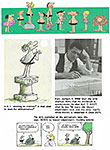
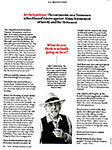

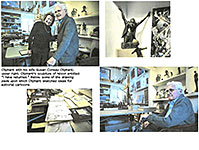
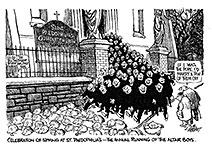
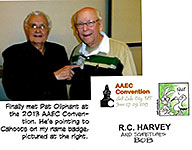
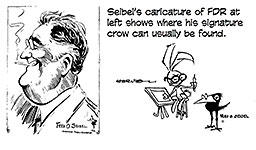
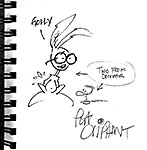

1.jpg)
2.jpg)
3.jpg)
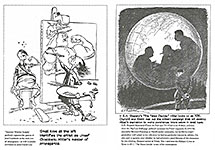
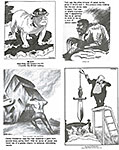
1.jpg)
2.jpg)
3.jpg)
4.jpg)
5.jpg)
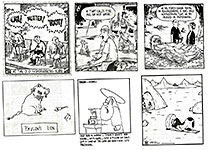
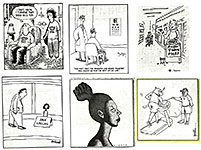
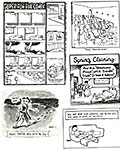
6.jpg)
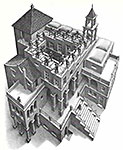

7.jpg)
8.jpg)
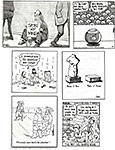
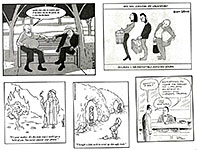
9.jpg)
10.jpg)
11.jpg)
12.jpg)
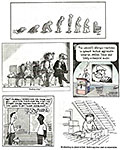
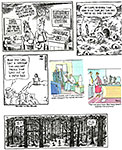
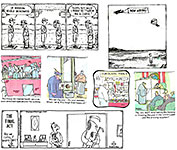
13.jpg)
14.jpg)
15.jpg)
16.jpg)
17.jpg)

